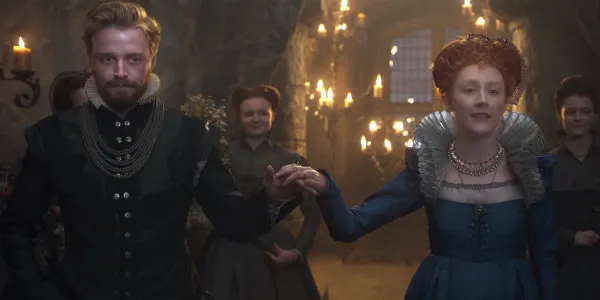
My wife and I have been anticipating Mary Queen of Scots for a while. We like good period pieces, although I am not sure this film qualifies with it's intentional use of anachronism. I think that choice was one of many that hurt this film. The story was infused with political correctness. A film about two strong female world leaders does not need anything more to make a statement. It is a statement. But Josie Rourke chose to muddy the waters with the intentional introduction of a kitchen sink of social justice issues. Focusing on the source material would have been more advisable.

Mary Stuart (Saoirse Ronan) ascended to the throne of Scotland as an infant, upon the death of her father. She was raised and educated in France. Her first marriage ended in the untimely death of her husband, leaving her a widow while still a teen. Mary Queen of Scots picks up the story with Mary's return to Scotland, where her brother James , Earl of Moray (James McArdle) has served as regent. The arrival of Mary, who has been raised Catholic, creates a stir among her subjects who are largely Protestant. Queen Elizabeth I (Margot Robbie) is also intrigued as well as threatened by the arrival of her cousin Mary in Scotland. Elizabeth, a Protestant, is also worried about her tenuous hold on England and Scotland, where much of the division is drawn along religious lines. The two correspond in letters and emissaries as they navigate the tenuous politics of sixteenth century England as female monarchs in a paternalistic society.

The screenplay for Mary Queen of Scots was rendered by Beau Willimon, based on the book Queen of Scots: The True Life of Mary Stuart by John Guy. The story was told primarily from Mary Stuart's perspective, although there is a solid story line from Queen Elizabeth's perspective. Using Queen Elizabeth's perspective created a nice counter-balance to the story. While the story is based on actual events, a lot of liberty was taken with the story. The two women meet in the film, although there relationship was strictly through letters and representatives in real life. The film is filled with minorities, almost to a fault. I believe the director wanted a minority in every scene, which he accomplished. I believe in inclusiveness, but I don't believe in revisionism. It was a distraction. Additionally, the writers created a homosexual relationship between Mary's husband and her secretary. It was an unnecessary stretch that didn't add anything of value to the story. In fact, it muddled the actual battle of wills between Mary and her advisors. The story itself held my attention. I liked the characters, even when frustrated by them. However, the pacing was slow, painfully so at times. That factor, more than the revisionism, is likely to hurt the ratings for this film.

The casting for Mary Queen of Scots was amazing. I believe Scarlett Johansson was originally cast in the lead role, more than a decade ago. The film has been in limbo since that time, which is okay. There is no way, in my humble opinion, that Johansson would have made half the Queen that Saoirse Ronan made. Ronan was perfectly cast in the role. She is amazing. I have a much easier time believing her to be as shrewd as she is beautiful. Johansson would have been a stretch. Beautiful? Yes. But the keen intellect would not have played as well with me. Ronan is currently one of my favorite actresses. And she chooses her roles well. Margot Robbie was equally exceptional as Elizabeth. You would never think Harley Quinn watching her performance. She was flawless. The casting centers on these two figures. In supporting roles, I think I enjoyed Guy Pearce and James McArdle best. The casting was excellent, with the exception of the decision to cast anachronistic characters for political reasons. History is history. Changing it in a film does not change it in reality, it merely adds window dressing to hard truths.

The MPAA awarded Mary Queen of Scots a well-deserved R rating. The film has plenty of material that earned the film this rating. The film has plenty of nudity and sex scenes. While the sex scenes are completed with little or no nudity, they leave little to the imagination. There is a brutal stabbing scene, a war that doesn't have much bloodshed, the murder of a key figure, and domestic violence. The film also has plenty of drinking, language and adult themes. Overall, the film is designed for adult audiences. I would suggest a bottom end in the mid-teens. The film runs two hours, four minutes.

IMDb is not currently showing much love for Mary Queen of Scots. As I write this, the rating is a paltry 6.5, which is a bit low for a film that was intended to draw Oscar attention. This film was built for the Oscars. Strong female leads, social justice, revisionism and all. The Oscars are often political. This could well be one of those films that wins an Oscar or two while getting panned by the general public. The casting was great, but the execution left a lot to be desired (no pun intended). The costumes and recreation of the era was rendered nicely, but the pacing was sluggish. I felt connected to the characters, even when troubled by the revisionist elements infused into this film. I am going to be a bit more kind than IMDb. No way should this film win an Oscar. Even if it does. 7/10.
